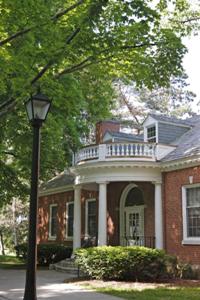Jun 3 2010
Green Mountain College has announced that one of its residence halls has been designated as a LEED® gold certified building by the U.S. Green Building Council. SAGE Hall, which stands for "Students for Academic and Green Engagement," is the seventh major gold certified building in Vermont and the first in Rutland County. It is also the first renovated college residence hall in Vermont to receive gold certification.
 Green Mountain College - SAGE Hall
Green Mountain College - SAGE Hall
"We're especially proud of the achievement because the project was completed through extensive renovation of an existing building, instead of new construction," said College president Paul J. Fonteyn.
Green Mountain College's honors residence hall with space for 26 students, SAGE Hall was renovated to strict environmental standards last summer.
Structures meeting basic requirements by the U.S. Green Building Council are deemed certified; those that go beyond minimum standards are eligible for silver, gold, and platinum ratings. Building features at SAGE include energy star windows, high efficiency lighting fixtures, low flow-bathroom fixtures and individual heating controls, Forest Stewardship Council-certified wood products, high R-value spray foam insulation, and low VOC (volatile organic compounds) flooring and furniture. Local materials, like the slate flooring in the solarium, were used whenever possible. The total cost for the renovation was $1.3 million.
"The greenest building is the building that's already standing," said assistant professor of environmental studies Lucas Brown, who served as an advisor on the project. "When we talk about energy use in buildings, the conversation often turns to operating energy: how much energy will be used for heating and lighting. But it takes a lot of energy and resources to construct a new building. In this renovation, 95% of SAGE's interior and exterior walls were retained."
When accounting for embodied energy—energy that's used to build a structure—renovation of existing buildings generally has a smaller environmental impact than building new structures. Studies show the energy required to manufacture a building is equivalent to the energy needed to heat or cool it for anywhere from 25 to 50 years.
President Fonteyn identified SAGE as one of his chief priorities in a campus community address in October 2008. Citing student support for regenerating existing space over a proposed new dormitory, he noted that renovating an existing building to accommodate students was a more environmentally sound practice than building a new residence hall.
Addressing graduating students on commencement day, May 15, Fonteyn announced, "Your logic won the day and the result was SAGE Hall—a building that epitomizes GMC's dedication to academic excellence and sustainability."
HP Cummings, a construction firm in Woodsville, N.H., managed construction of the project. The architect is Smith-Alvarez-Sienkiewycz of Burlington.
Source: http://www.greenmtn.edu/